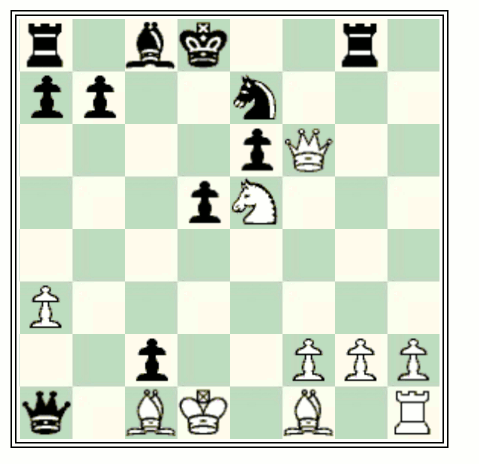At one time the Winawer made regular appearances at the highest levels, even in World Championship matches (Smyslov-Botvinnik, Tal-Botvinnik) but these days it’s a relatively rare occurrence. It’s therefore a delight to see two 2600+ grandmasters battle it out in a major tournament, and indeed in one of the wildest and most obscure lines of the Posioned Pawn variation. Hot off the presses (the game was played yesterday as I write) comes Perunović–Édouard, European Teams Championship, Reykjavik 2015.
 After 10. Kd1
After 10. Kd1 Nd7!? Nbc6 11. Nf3 Nxe5 12. Bf4 Qxc3 13. Nxe5 Qxa1+ 14. Bc1 (see The New Winawer Report issues 7 and 10), Édouard tried 14. … d3?!, introduced in Bronstein–Uhlmann, United Nations Peace Tournament, Zagreb (April-May) 1965 (better 14. … Rf8). After 15. Qxf7+ Kd8 16. Qf6 dxc2+ the game reached the diagrammed position.
In issue 10, I argued that the less common 17. Kxc2! is best, leading to a clear advantage, though falling short of a forced win. But Perunović chose the older 17. Kd2. The continuation was 17. … Qd4+ 18. Bd3 Qc5! 19. Ke2 Bd7 20. Be3 d4? 21. Bxd4. All this is as in B. Stein-Beliavsky, Lloyds Bank Masters 1985 (later agreed drawn in a winning position for White): I think Black is already lost. The improvement 20. … Qxa3!?, which I think was suggested by Stein and Andrew Martin in the tournament book, seems to allow Black to survive.
Though I believe Black has objective equality after 17. Kd2?, in practice the position is very difficult to hold. You might try considering what happens after the (all tried in practice) alternatives in this sequence 17. … d4, 17. … Qb1, 19. Bb2, and 20. Bf4.
[Update, same day: the conclusions above were based on analysis I did around three years ago. Re-evaluating now, with a better engine of course (Houdini 4.0), it seems that 20. … d4 21. Bxd4 Qxa3 is also fine for Black (=, with a perpetual in the main line). White is better after 20. … Qd5, but it’s less than clear whether it’s a win.]
[Update, November 20, 2015: At ICC, this game features in GM Joel Benjamin’s Game of the Week video (about 35 minutes; subscription required; 5-minute preview available). Even if you are not especially interested in this line, Benjamin gives some fascinating variations. These include some new analysis of 20. … Qxa3 far out, leading to a position where ‘White is better but Black is still hanging around’. Highly recommended!]
[Update: November 21, 2015: If 20. … Qxa3, Benjamin gives 21. Ra1!, which causes Black some difficulties. So after thinking about it some more, I think the best course for Black is 20. … d4! (after all) 21. Bxd4 Qxa3!. One point is that the bishop no longer covers c1, so that 22. Ra1? is met by 22. … Qxa1 23. Bxa1 c1=Q, winning. Another is that compared to the alternative 21. … c1=Q? (from B. Stein-Beliavsky above), the black queen covers d6, preventing White’s Nf7+-d6xb7 manœuvre. White appears to stand worse in all lines except for 22. Nf7+ Ke8 (or 23. … Kc8 24. Qe5 c1=Q 25. Rxc1 Qxc1 26. Nd6+ with a perpetual) 23. Be5 Nf5 23. Bxf5 Bb5+ 24. Kd2 Qb4+ 25. Kc1 Qb1+ 26. Kd2 Qb4+=.]
